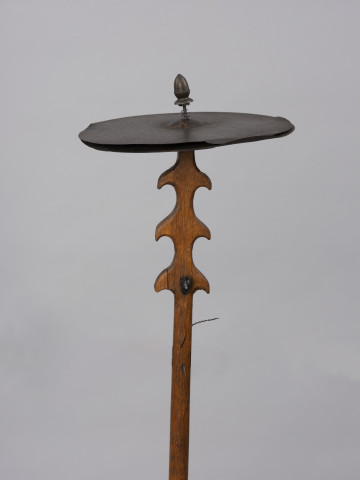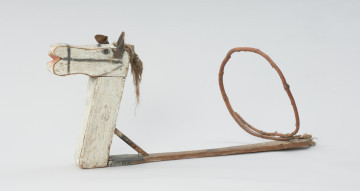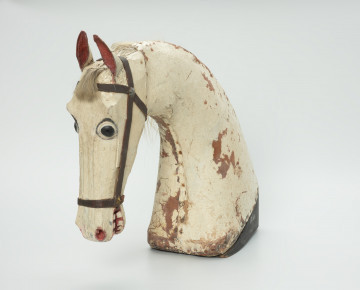
Bladder fiddle (Deil's fiddle)
1901 — 1945
National Museum in Szczecin
Part of the collection: Material culture of West Pomerania
In Pomerania, the old Slavic custom of carol singers visiting houses to wish the inhabitants luck and good harvests was cultivated during the Christmas and carnival season. It was still practised in the first half of the 20th century. One of the most common characters in carol groups was Turoń. Description of its appearance can be found in Stefan Żeromski’s Ashes: “It turned out that the first sleigh was carrying a “Turoń”, or “Kłapacz” they had met on the way, i.e., a man dressed as a monster with a tall neck like a giraffe's and a moving jaw, lined with red cloth”. Regardless of the region, all Turons looked similar to one another, and fit the description from Ashes. The carol singer who played the monster, usually a tall and strong young man, was dressed in a sheepskin turned inside out, its hairiness could be perceived as a symbol of fertility and wealth. There was an underlying symbolic meaning in the scenes he played out. The turning point of the performance was when the dancing, mischievous Turoń suddenly dropped dead to the ground, and then with the power of disenchanting operations performed by one of the companions, it was brought back to life. Death of Turoń symbolised the winter slumber of nature, and its resurrection was meant to inspire in people hope that nature, just like the dead monster, will come back to life and produce crops people need to survive. In the collection of the Department of Ethnography of Pomerania of the National Museum in Szczecin, there are two Turons. The monster presented here comes from the 1st half of the 20th century (around 1920). The animal’s head, made from wood, is painted black, while the nostrils and inside of its distinctive long, snapping snout are painted red. Turoń has metal ears and horns.
Agnieszka Słowińska
Author / creator
Dimensions
cały obiekt: height: 27 cm, width: 47 cm
Creation time / dating
Creation / finding place
Identification number
Location / status

1901 — 1945
National Museum in Szczecin

1. połowa XX wieku
National Museum in Szczecin

1. połowa XX wieku
National Museum in Szczecin
DISCOVER this TOPIC
National Museum in Szczecin
DISCOVER this PATH
Educational path